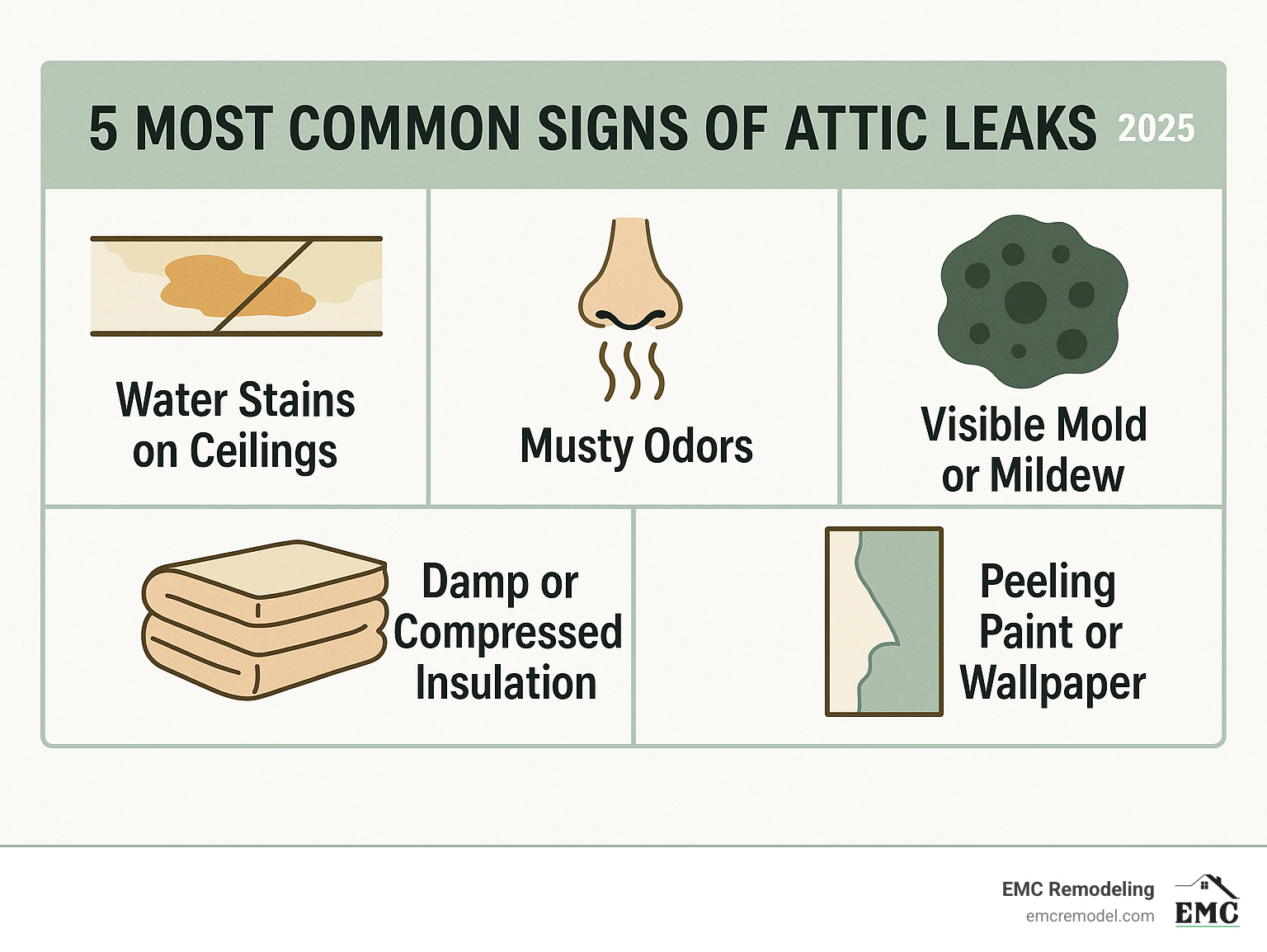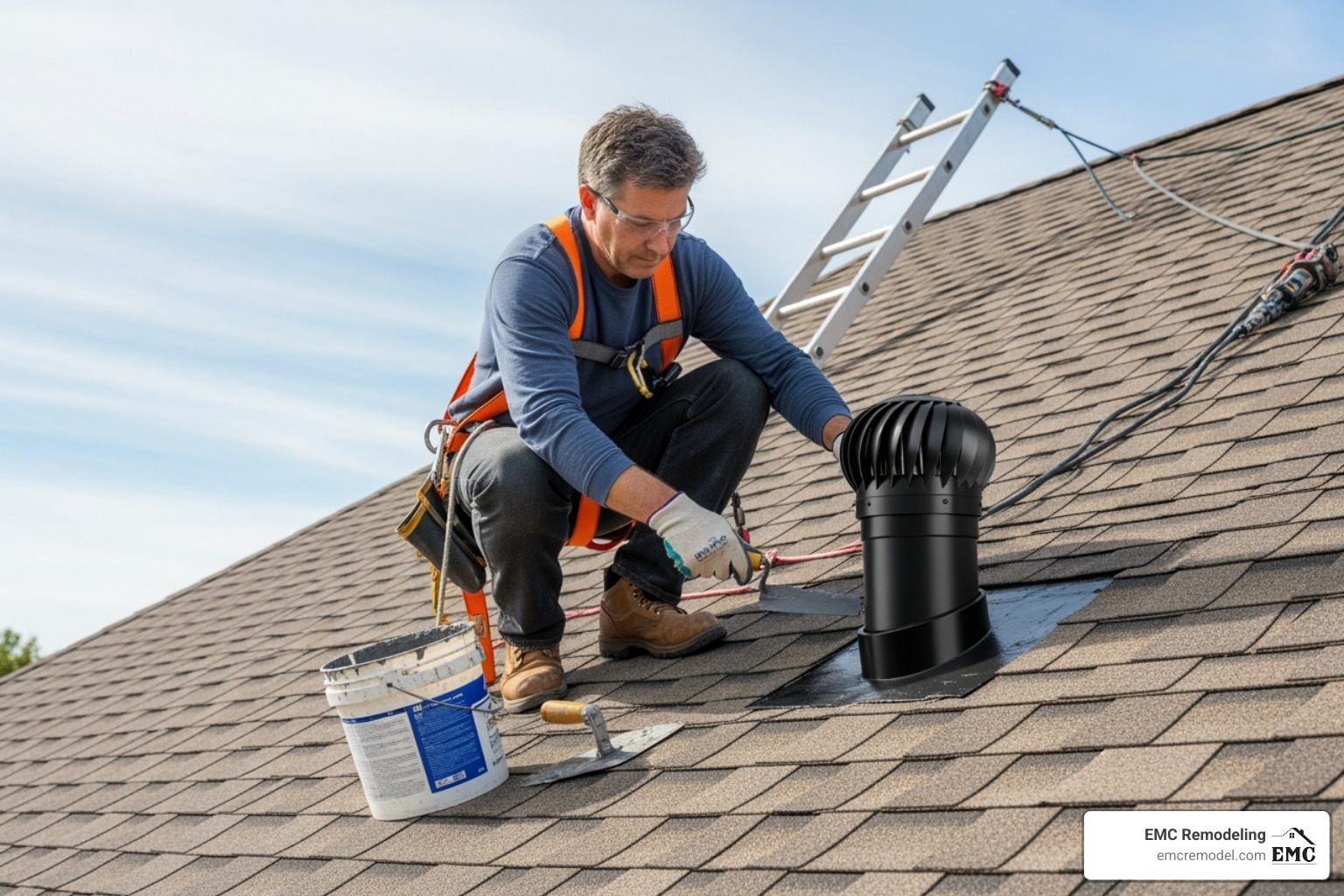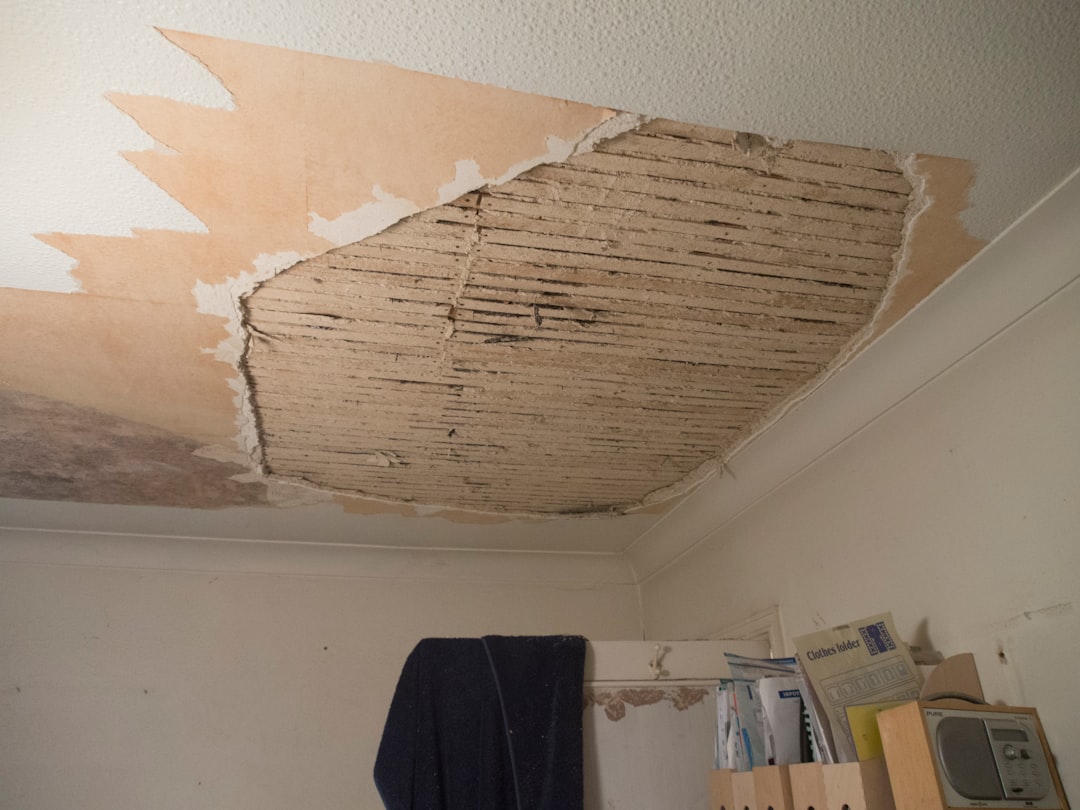Why Quick Attic Leak Repair is Critical for Central Texas Homes
An attic leak repair is more than just stopping a drip; it’s about protecting your entire home from serious, costly damage. For homeowners in Central Texas, having a plan is essential. With our region’s unpredictable weather, a small leak can quickly escalate, but with the right knowledge and expert roofing and remodeling services, you can safeguard your most valuable asset. This guide will walk you through every step, from immediate damage control to long-term prevention.
If you find a leak, act fast. Prioritize safety by turning off electricity near the water, then contain the drip with buckets and move belongings. Next, try to find the source by tracing water stains uphill in your attic. A temporary fix like a tarp or roofing tape can mitigate damage until a permanent solution is found. For anything more than a minor drip, it’s best to call a professional.
Most homeowners don’t realize that a staggering 70-90% of home catastrophe losses are roof-related. In Central Texas, knowing how to handle an attic leak can save you thousands. Whether you’re dealing with storm damage requiring immediate attention or a minor issue, this guide will help you protect your home and family.

First Steps: How to Find the Source of Your Attic Leak

Finding the source of a leak is the first challenge in attic leak repair. Water can travel along rafters and beams, meaning the drip you see in your living room could originate from a spot 10 feet away on the roof. Think of yourself as a detective following clues back to the entry point.
Spotting the Telltale Signs
Your home will give you clues that something is wrong. Look for brown or yellow water stains on your ceiling, which often grow over time. Other signs include peeling paint on walls or ceilings, a persistent musty odor indicating trapped moisture, or visible mold or mildew growth. In the attic itself, the most obvious signs are damp, compressed insulation that has lost its fluffiness, or even standing puddles of water.
Tracing the Leak to Its Origin
Once you’re ready for an attic inspection, grab a good flashlight or headlamp. The key is to follow water stains uphill. Since water flows down, the entry point will always be higher than the visible damage. Carefully inspect the roof sheathing (the plywood base of your roof) for dark spots or discoloration. Check the wooden rafters and joists for similar stains or soft spots.
If the source isn’t obvious, a water hose test can help. With one person on the roof with a hose and another in the attic, soak the suspected area and watch for drips. This can take several minutes, so be patient. Also, look for “shiners”—roofing nails that missed the joist and poke through the sheathing, as they can wick moisture inside. Finally, be sure you’re dealing with a leak and not condensation, which points to a ventilation issue. Most true leaks occur around penetrations like chimneys, vents, and skylights, where flashing and seals can fail.
Common Causes and Immediate Damage Control
Understanding the cause of the leak is key to a successful attic leak repair. Most issues originate on the roof itself, where materials are constantly exposed to the elements.
The Most Common Culprits Behind a Leaky Roof
- Damaged or Missing Shingles: Wind, hail, or age can crack, lift, or remove shingles, creating a direct path for water.
- Cracked or Corroded Flashing: The metal strips around chimneys, vents, and skylights can fail over time, allowing water intrusion.
- Damaged Vent Boots: The rubber seals around plumbing pipes on your roof can crack and deteriorate from sun exposure.
- Clogged Gutters: When gutters overflow, water can back up under the edge of your roof and seep into the attic.
- Aged Roofing Materials: Roofs have a finite lifespan. As materials become brittle with age, they are more susceptible to leaks.
- Improper Installation: Poor workmanship, such as incorrectly nailed shingles, can create leak points from the start.
Temporary Fixes to Mitigate an Active Leak
When you find an active leak, quick action can minimize damage. First, place buckets under drips to contain the water. If you can’t move furniture or other belongings, cover them with thick plastic sheeting.
For small holes, applying roofing tape or cement from inside the attic can be a safe, temporary patch. Make sure the area is clean and dry before application. If weather conditions are safe and you can access the roof, covering the damaged area with a waterproof tarp is a highly effective temporary measure. Secure the tarp so that it extends well beyond the leak and is taut enough for water to run off. These are stopgap solutions to buy you time until a professional can perform a permanent repair.
Your Guide to DIY Attic Leak Repair and When to Call a Pro

While some minor fixes are possible for a handy homeowner, it’s crucial to know your limits. An improper attic leak repair can lead to bigger problems and may even void your roof’s warranty. What starts as a small DIY project can quickly become a costly professional job if not done correctly.
Minor attic leak repair tasks you can handle
For very small, isolated leaks, a confident DIYer might handle these temporary fixes while awaiting a professional. Always prioritize safety.
- Sealing Small Holes: Use a high-quality waterproof sealant on tiny cracks or nail holes from inside the attic, ensuring the surface is clean and dry.
- Applying Roofing Cement: This can temporarily patch minor cracks in flashing or small shingle tears. Apply with a putty knife to cover the damaged area.
- Replacing a Single Shingle: If you have a matching shingle and the area is easily accessible, you can carefully replace one damaged shingle. Be sure to seal the new nail heads.
For more detailed guidance, A guide to repairing a leaky roof offers additional insights. These are temporary measures.
When to Call for Professional Help
Attempting a DIY repair is not worth the risk to your safety or your home’s integrity in certain situations. Call a professional immediately if you encounter any of the following:
- Large or Multiple Leaks: This indicates a systemic problem that a patch job won’t solve.
- You Can’t Find the Source: Professionals have tools like moisture meters to find hidden leaks.
- Steep or Unsafe Roof: Never work on a roof that is steep, high, wet, or icy.
- Signs of Structural Damage: A sagging roof deck or ceiling requires immediate expert assessment.
- Leaks Around Chimneys or Skylights: These areas have complex flashing that requires specialized knowledge.
- You’re Uncomfortable with Heights: Your safety is paramount.
In an urgent situation with significant water intrusion, you need emergency roof repair services. The cost of professional repair is often far less than the cost of fixing secondary damage from an improper fix, such as mold remediation or structural work.
Prevention and Long-Term Consequences
A timely attic leak repair is crucial because the visible drip is often just the tip of the iceberg. Unchecked, water will continuously damage your home’s structure.
The Long-Term Consequences of Ignoring an Attic Leak
Delaying repairs can lead to severe and expensive problems:
- Structural Wood Rot: Constant moisture rots the wooden framework of your attic, including rafters, joists, and the roof deck. This can compromise the integrity of your entire roof.
- Widespread Mold and Mildew: A damp attic is a perfect breeding ground for mold, which can spread through your home’s HVAC system and pose health risks.
- Damaged Insulation: Wet insulation loses its R-value, becoming ineffective. This leads to higher energy bills and costly replacement.
- Compromised Electrical Wiring: Water near electrical wiring is a serious fire and electrocution hazard.
- Ceiling and Drywall Damage: Water stains can quickly lead to sagging, bubbling, and collapsed ceilings.
How to Prevent Future Attic and Roof Leaks
Most roof leaks are preventable with proactive maintenance. Follow these steps to protect your home:
- Schedule Regular Roof Inspections: An annual professional inspection can catch small issues before they become major leaks.
- Keep Gutters Clean: Clean gutters at least twice a year to prevent water from backing up onto your roof.
- Ensure Proper Attic Ventilation: Good airflow prevents moisture buildup and condensation that can mimic leaks.
- Trim Overhanging Tree Branches: This prevents branches from scraping shingles or falling and causing damage during a storm.
- Address Minor Damage Immediately: Fixing a single cracked shingle right away is much cheaper than a major repair project later.
Essential Safety Precautions for Attic and Roof Work
No attic leak repair is worth a trip to the emergency room. Working in attics and on roofs is inherently dangerous, and your safety must always come first. If you must enter these spaces for inspection or a temporary fix, follow these precautions.
Working Safely in the Attic
- Walk Only on Joists: Never step on the drywall or insulation between the wooden joists. Lay down plywood planks for a stable path.
- Use Proper Lighting: A headlamp or bright flashlight is essential for spotting hazards like exposed nails or wiring.
- Wear Protective Gear: A dust mask, gloves, and safety glasses are crucial to protect you from insulation fibers, dust, and mold.
- Watch for Hazards: Be aware of sharp roofing nails poking through the roof deck and potentially compromised electrical wires.
- Move Slowly: Attics are cramped and uneven. Take your time to ensure stable footing with every step.
Safety on the Roof
Roof work is best left to professionals. If you must access your roof for a brief, temporary fix, these rules are non-negotiable:
- Use a Sturdy Ladder: Ensure your ladder is on stable ground and extends three feet above the roofline. Maintain three points of contact when climbing.
- Wear Non-Slip Boots: Soft-soled boots with good traction are essential to prevent slips and protect your shingles.
- Never Work in Bad Weather: Do not go on a roof that is wet, icy, or in windy conditions.
- Have a Spotter: Always have someone on the ground to steady the ladder and call for help if needed.
- Use Fall Protection: For any significant work, a personal fall arrest system is necessary. Review this guide provided by Princeton University for more details.
Don’t Let a Small Drip Become a Big Problem
A tiny drip in your attic is an urgent warning that your home’s primary defense against Central Texas weather has been compromised. Delaying an attic leak repair allows a small issue to grow into a major problem, threatening your home’s value and your family’s safety.
By quickly identifying the source, applying temporary fixes, and knowing when to call a professional, you can prevent a disaster. Regular maintenance is your best defense, but when storms strike unexpectedly, a fast response is critical.
If you’re facing a leak that’s beyond a simple DIY patch, don’t wait. The owner-led team at EMC Remodeling understands the urgency and provides transparent, effective solutions to protect your home. When water is dripping into your house, every hour counts. For situations that demand immediate attention, don’t hesitate to seek professional emergency roof repair.

